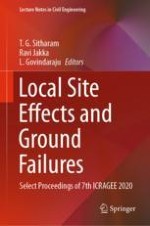2021 | OriginalPaper | Chapter
Reliability-Based Assessment of Liquefaction Potential Using SPT Approach
Authors : G. S. Bhatia, K. Bhargava, A. Mondal
Published in: Local Site Effects and Ground Failures
Publisher: Springer Singapore
Activate our intelligent search to find suitable subject content or patents.
Select sections of text to find matching patents with Artificial Intelligence. powered by
Select sections of text to find additional relevant content using AI-assisted search. powered by
